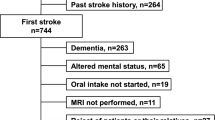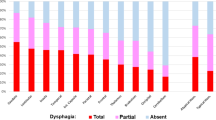Abstract
In order to assess the risk of pneumonia, dehydration, and death associated with videofluoroscopic evidence of aspiration following stroke, the clinical records of 26 patients with aspiration and 33 randomly selected, case-matched, dysphagic controls without videofluoroscopic evidence of aspiration were reviewed. The videofluoroscopic modified barium swallow technique included 5 ml-thin and thick liquid barium, 5 ml barium pudding, and 1/4 cookie coated with barium, plus additional 20 and 30 ml of thin liquid barium. Patients were assessed a mean of 2±1 SD months poststroke and were followed for a mean of 16±8 SD months poststroke. The odds ratio for developing pneumonia was 7.6 times greater for those who aspirated any amount of barium irrespective of its consistency (p=0.05). The odds ratio for developing pneumonia was 5.6 times greater for those who aspirated thickened liquids or more solid consistencies compared with those who did not aspirate, or who aspirated thin liquids only (p=0.06). Dehydration was unrelated to the presence or absence of aspiration. The odds ratio for death was 9.2 times greater for those aspirating thickened liquids or more solid consistencies compared with those who did not aspirate or who aspirated thin liquids only (p=0.01). Aspiration documented by modified videofluoroscopic barium swallow technique is associated with a significant increase in risk of pneumonia and death but not dehydration following stroke.
Similar content being viewed by others
References
Kuhlemier K, Rieve J, Kirby N, Siebens A: Clinical correlates of dysphagia in stroke patients. Arch Phys Med Rehabil. 70: (special annual meeting issue, A-56) 1989
Gordon C, Hewer R, Wade D: Dysphagia in acute stroke. Br Med J 295:411–414, 1987
Wade D, Hewer L: Motor loss and swallowing difficulty after stroke: frequency, recovery and prognosis. Acta Neurol Scand 76:50–54, 1987
Horner F, Massey E, Riski J, Lathrop D, Chase K: Aspiration following stroke: clinical correlates and outcome. Neurol 38:1359–1362, 1988
Linden P, Siebens A: Dysphagia: predicting laryngeal penetration. Arch Phys Med Rehabil 64:281–284, 1983
Veis S, Logemann J: Swallowing disorders in patients with cerebrovascular accident. Arch Phys Med Rehabil 66:372–375, 1985
Barer D: The natural history and functional consequences of dysphagia after hemispheric stroke. J Neurol Neurosurg Psychiatry 52:236–241, 1989
Sacco R, Wolf P, Kannel W, McNamara P: Survival and recurrence following stroke: the framingham study. Stroke 13:290–295, 1982
Logemann J: Evaluation and Treatment of Swallowing Disorders. Boston: Little Brown and Co., 1983
Rimm A, Hartz A, Kalbfleisch J, Anderson A, Hoffmann R: Basic Biostatistics in Medicine and Epidemiology. London: Appleton-Century-Crofts, 1980, pp 296–299
Robbins J, Levine R: Swallowing after unilateral stroke of the cerebral cortex: preliminary experience. Dysphagia 3:11–17, 1988
Author information
Authors and Affiliations
Rights and permissions
About this article
Cite this article
Schmidt, J., Holas, M., Halvorson, K. et al. Videofluoroscopic evidence of aspiration predicts pneumonia and death but not dehydration following stroke. Dysphagia 9, 7–11 (1994). https://doi.org/10.1007/BF00262752
Issue Date:
DOI: https://doi.org/10.1007/BF00262752




